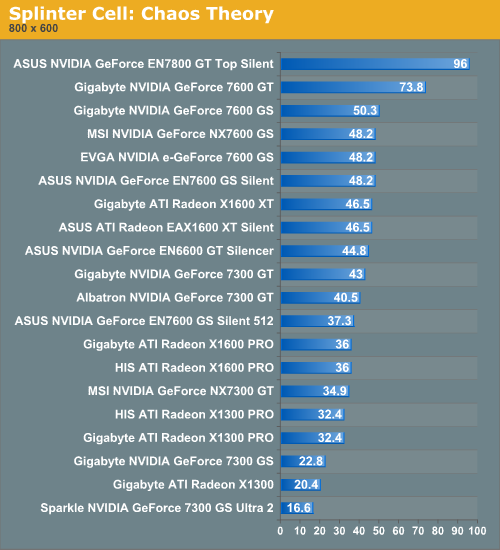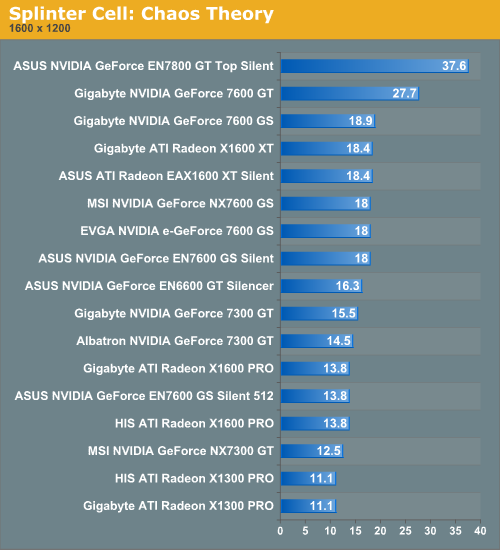Splinter Cell: Chaos Theory
Splinter Cell: Chaos Theory is a stealth-style game that has been around a while and that we've used many times for testing graphics cards. Because it's more of a slow-paced game and is mostly third-person, it can be enjoyed with a lower fps than fast-paced games like Battlefield 2 and Quake 4. Generally, a frame rate of about 20 FPS is as low as you would want to go when playing this game (depending of course on personal preference). The benchmark for this game is simply a recorded demo of the game play through the first level starting from the beach and ending at the first interrogation cell.




The first thing we notice is that unlike with Half-Life 2: Episode One, ATI hardware generally does a little better than NVIDIA with this game, and it's more noticeable on the low end. The Sparkle 7300 GS Ultra 2 has trouble running this game at all resolutions, but the 16.6 fps at 800x600 might be playable with this card, given the slower gameplay. Almost all of these cards won't be able to run this game smoothly at 1600x1200.
We can see that the X1600 XT performs very similarly to the factory-overclocked Gigabyte 7600 GS across all resolutions in this game, but the price for the Gigabyte 7600 GS is low enough right now that it would still be a better choice than the Gigabyte or ASUS X1600 XT, especially considering it will be a better choice for a lot of other games.
Splinter Cell: Chaos Theory is a stealth-style game that has been around a while and that we've used many times for testing graphics cards. Because it's more of a slow-paced game and is mostly third-person, it can be enjoyed with a lower fps than fast-paced games like Battlefield 2 and Quake 4. Generally, a frame rate of about 20 FPS is as low as you would want to go when playing this game (depending of course on personal preference). The benchmark for this game is simply a recorded demo of the game play through the first level starting from the beach and ending at the first interrogation cell.




The first thing we notice is that unlike with Half-Life 2: Episode One, ATI hardware generally does a little better than NVIDIA with this game, and it's more noticeable on the low end. The Sparkle 7300 GS Ultra 2 has trouble running this game at all resolutions, but the 16.6 fps at 800x600 might be playable with this card, given the slower gameplay. Almost all of these cards won't be able to run this game smoothly at 1600x1200.
We can see that the X1600 XT performs very similarly to the factory-overclocked Gigabyte 7600 GS across all resolutions in this game, but the price for the Gigabyte 7600 GS is low enough right now that it would still be a better choice than the Gigabyte or ASUS X1600 XT, especially considering it will be a better choice for a lot of other games.










49 Comments
View All Comments
imaheadcase - Thursday, August 31, 2006 - link
I guess to each his own, i play bf2 on a 19inch CRT monitor at 1024x768. But even if i had a better card i would still prefer lower rez.DerekWilson - Thursday, August 31, 2006 - link
it's an issue of how games work on the inside ...all the objects, shapes, characters, and landscapes are there no matter how you see them. everything is mathematically represented in the software. rendered onto your display is a viewport into the world. this viewport only allows you to see a fixed grid of colors. the color of each pixel is determined by a bunch of factors, but the largest contribution is made by the object that projects onto a particular pixel.
... on second thought, this is too hard for me to explain with out a lot of math. lets look at it another way.
when there's a naked person on tv, they decrease the resolution of the area over the persons naughty bits. this makes it harder to see what's really there because there is a smaller number of large pixels that can only represent one color each. it follows, then, that it would also be harder to shoot the person acurately in said bits.
I think your preference may be based on your experience with performance at higher resolutions. Responsiveness is necessary for a quality experience in games like bf2. If you get a faster card, I would encourage you to at least try a higher resolution.
blckgrffn - Thursday, August 31, 2006 - link
When it is in stock at newegg, its ~$90, not nearly $140.Nat
mostlyprudent - Thursday, August 31, 2006 - link
I would be interested to know how much noise (quantitatively) an actively cooled 7600GS or 7600GT contributes to a system built in a relatively quiet case like an Antec P150. I am familiar with some of the leaf blowers attached to the higher end cards, but wonder how much overall system noise savings you'ld get in the mid-range cards.wilburpan - Thursday, August 31, 2006 - link
One obvious use for silent video cards would be in an HTPC system, where quiet performance would be a priority. Can't have those noisy computer fans intrude on watching Snakes on a Plane, you know. :@) Anyway, it would have been nice to include some video playback benchmarks to see how these cards can handle playing back a 1080p HDTV signal, or similiar tests.ViRGE - Thursday, August 31, 2006 - link
Since HDTV is MPEG2, any modern video card should be able to handle a 1080P signal(since this is an either/or case, it either can or can't). The limitations come in to H.264, where the video decode engine may not be clocked high enough to do higher resolution decoding. Unfortunately, I'm not sure there's any 1080 commerical/usable content that would work with Cyberlink/Intervideo's H.264 decoders(the only ones with GPU acceleration), since Quicktime content doesn't work in those.DerekWilson - Thursday, August 31, 2006 - link
with nvidia, the video decode engine is clocked off the core -- it actually will run better on a card with fewer pipelines and a higher core speed ... iow, the 7600gt is a better video decode graphics card than a 7900gt at default clock speeds.a little counter intuitive, but there it is.
nvidia 7 series parts with a core clock of >450 MHz should have no problem accelerating 1080p decode on players that support purevideo.
MontagGG - Thursday, August 31, 2006 - link
Which of these have HDCP?DerekWilson - Thursday, August 31, 2006 - link
to my knowledge, none of the cards tested here support hdcp. but I will certainly try to confirm this ...